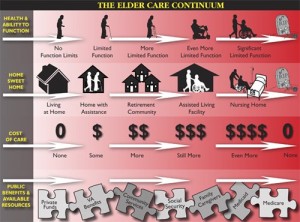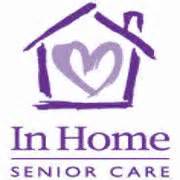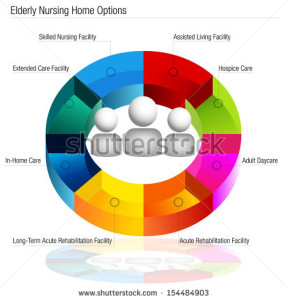Deciding to move out of one’s home and into a different type of housing is often a difficult decision for elders or people with disabilities and their caregivers. Caregivers often struggle to care for loved ones so they are able to remain at home as long as possible. However, there often comes a time when moving someone to a residential care facility may become the most realistic way to provide the best care, and the only way to relieve a caregiver’s overwhelming burden.
If you or a loved one is considering a move to an out-of-home living situation, you might be confused by all the housing options. Will a board-and-care home, assisted living facility, or nursing home be the best choice? And what are the differences between these housing options?
This Fact Sheet provides an overview of residential options that offer some level of medical and/or personal care services for elders and others who need assistance in daily living. It does not cover housing options such as independent living and senior apartments, which do not include health services.
The Fact Sheet describes different types of housing, how much they cost, and how to choose a good facility. The goal is to help you decide which facility would be the most comfortable, safe, appropriate and affordable for your loved one.
Is It Time for a Move?
An increase in certain “special care needs” often triggers discussions about moving into residential care. These care needs might include: incontinence, wandering, sleeplessness, combative and other difficult dementia behavior, tube feeding, skin care treatment, and assistance with transferring (e.g., moving someone from bed to chair). It is common to find that the emotional well-being of the care receiver is also a factor: if the care receiver is suffering from depression, for example, it is more difficult for the caregiver to sustain long-term care.
Another turning point is when the person can no longer attend adult day care, requiring the family to provide care 24 hours a day. It is also common for a placement decision to be made after a crisis or hospitalization. A decline in the physical health of the caregiver is another major reason for placement.
Making the Transition from Home to Residential Facility
If you and your family have decided that it may be time for your loved one to move into a facility, the following tips may help towards a peaceful transition:
- Don’t wait for a crisis: plan ahead. Learning about your options can help reduce the confusion and trauma of a move and lessen the emotional ordeal for both you and your loved one. A thoughtful comparison of available choices will help all involved gain insight into finding the most appropriate setting and level of care for your loved one. The process will assist you in making informed decisions that will help you and your family regain a sense of control over what might feel like an unmanageable situation.
- Have a family meeting: Whenever possible, the decision to move into a facility should be discussed fully with your loved one. (When you are dealing with a cognitive disorder such as advanced Alzheimer’s disease, however, you may have to make the decisions without their participation.) In addition, you and your family members, a social worker, case manager, hospital discharge planner, financial planner and/or spiritual advisor can be helpful in making sure that your loved one’s needs will be met and that your family feels comfortable with the move.
- Determine your loved one’s particular housing needs: One of the most important steps in finding the right facility for your loved one is thinking about his or her particular needs.
- What level of care does she or he need?
- How much independence and privacy is the right level for your loved one?
- Does your loved one have any physical or cognitive impairment?
- What are your loved one’s likely future needs?
- Is a smaller or larger facility likely to work better?
- Get support for you: Many caregivers feel guilty about moving a loved one into a facility. If you are having these feelings, it may help to speak to a counselor or support group. And remember that putting your loved one in a residential facility may be the best choice for his or her health and safety as well as your own well-being.
Getting Started
One place to begin your search for elder housing (and caregiver support programs for you) is with your local Area Agency on Aging (AAA). You can find your local AAA by visiting the Eldercare Locator website or by calling (800) 677-1116.
- Your AAA can provide the following:
- A list of licensed facilities in your area.
- Licensing regulations for your state.
- Contact information for your long-term care ombudsman.
- Contact information for Medicare and Medicaid in your state (Medi-Cal in California).
One helpful way to begin this process is to hire a geriatric care manager familiar with local facilities to help you find a new residence for your loved one. Care managers usually charge a fee for their services. To find a geriatric care manager near you, visit the National Association of Professional Geriatric Care Managers or call (520) 881-8008. Some community organizations may also provide this service at lower cost.
Types of Facilities: What’s in a Name?
To help you determine which type of housing might be right for your loved one, you must become familiar with what options exist and what services they provide. Housing options vary widely in terms of size, cost, services and facilities. Be aware also that the terms used to describe these options may vary from state to state. The following list describes the most common housing options and key features (please note that key features listed are normally, but not always, present).
Board and Care Homes
(Also known as: Residential Care for the Elderly [RCFE], Personal Care Homes, Sheltered Housing, Homes for Adults, Domiciliary Care, Adult Foster Care or Senior Group Homes.)
Board and care homes are smaller in scale than assisted living facilities, though many states consider them to be one form of assisted living. Some board and care facilities are specialized (e.g., serving only residents with Alzheimer’s disease). They provide a room, meals, and help with daily activities.
- Number of Residents: Usually up to six.
- Cost: Often lower than other facilities.
- Setting: Many of these are in traditional homes in residential neighborhoods. Residents may share bathrooms, bedrooms and living spaces.
- Services: Meals; help with daily activities (though some provide limited nursing level care, such as administering medications); and sometimes social activities.
- Medicare/Medicaid Reimbursable: Medicare does not cover; Medicaid 1915c waivers can be used in most states to pay for services. SSI may also be used for payments.
- Features: Personal, family-style care.
For more information:
Contact the Area Agency on Aging near you (see Getting Started) or visit their online Helpguide.
Assisted Living Facilities
(Also known as Residential Care Facilities or Adult Congregate Living.)
Assisted living communities are designed for individuals who have difficulty living alone, but do not need daily nursing care. Unfortunately, the definition of the term “assisted living” varies from state to state, as each state has its own licensing requirements and regulations. Families need to visit facilities and ask detailed questions to know what services each facility offers.
- Number of Residents: Varies widely; 40 to 100 rooms is typical.
- Cost: Midlevel; the national average in 2004 was $2,524 per month, but may be much higher in some communities. Costs depend on what level of service the person requires, and increase as the number of services increases. Most facilities charge a basic monthly rate that covers rent and utilities, and then charge separately for services. Many facilities also charge a one-time entrance fee.
- Setting: Facilities may only have bedrooms or they may have full apartments, with a large dining room and lounge for residents to come together.
- Services: Housekeeping services (as in a hotel); meals; help with daily activities; transportation to appointments; medication reminders and administration; social and recreational activities; 24-hour supervision.
- Medicare/Medicaid Reimbursable: Medicare does not cover; Medicaid 1915c waivers can be used in most states to pay for services.
- Features: Apartment-style living; privacy and independence with a menu of services to choose from.
For more information:
Choosing An Assisted Living Residence: A Consumer’s Guide
National Center for Assisted Living (NCAL) (202) 842-4444 http://www.ahcancal.org/ncal/Pages/index.aspx
Assisted Living Federation of America (703) 894-1805 http://www.alfa.org
Provider Magazine’s 2012 Top 40 Assisted Living Chains http://www.providermagazine.com/reports/pages/0612/2012-top-40-assisted-living-companies.aspx
Consumer Consortium on Assisted Living (703) 533-8121 http://www.ccal.org
Nursing Homes
(Also called Skilled Nursing Facility (SNF), Convalescent Hospitals or Rest Home).
Nursing homes provide care for individuals who need nursing care without being in a hospital, as well as recreation and help with daily activities.
- Number of Residents: Average of 109 beds per nursing home nationally.
- Cost: High. The national average in 2004 was $5,070-5,760 per month; costs vary widely among geographic regions.
- Setting: Large facilities, often in a hospital- like setting.
- Services: Medical services and 24-hour nursing care; help with daily activities; recreation; rehabilitative care (e.g., physical therapy).
- Medicare/Medicaid Reimbursable: Medicare pays for up to 100 days of care, however, individuals must be referred by a physician upon hospital discharge and have the need for skilled nursing care. Often, Medicare will pay only for a few weeks of rehabilitation services after hospitalization. Medicaid is accepted by many homes for ongoing care, but a person’s eligibility must be established.
- Features: Provides the highest level of supervision and medical services for residents compared to other facilities. A more recent movement, spearheaded by such organizations as the Eden Alternative and Greenhouse Project, aims to provide more client-centered care than traditional nursing home models. However, these alternatives are not yet available in all areas of the country.
For more information:
National Citizens Coalition for Nursing Home Reform (202) 332-2275 http://www.nccnhr.org
Nursing Home Compare (800) MEDICARE http://www.medicare.gov/nursinghomecompare/search.html
For nationwide nursing home ratings and quality of care information: http://www.Memberofthefamily.net
National Long Term Care Ombudsman Resource Center (202)332-2275 http://www.ltcombudsman.org
Eden Alternative/Green House Project http://www.edenalt.com/
Continuing Care Retirement Communities (CCRCs)
(Also known as Life Care Facilities.)
CCRCs are usually large complexes that offer options ranging from independent living to skilled nursing home care. These facilities are specifically designed to provide lifetime care within one community, so residents often move there when still independent and then change residences within the community if medical and/or personal care services are needed. Residents cannot be made to leave because of a worsening condition.
- Number of Residents: Many.
- Cost: High. Most communities require a buy-in fee and monthly payments. These fees can range from lows of $20,000 to highs of $400,000 and more. Monthly payments can range from $200 to $2,500 or more.
- Setting: Large campuses with many buildings, usually including separate homes, assisted living facilities and nursing homes.
- Services: Depend on which type of facility person resides in. All levels of care are accommodated.
- Medicare/Medicaid Reimbursable: Medicare does not cover; Medicaid may pay for services in nursing home.
- Features: Ability to move to higher level of care if needed without having to relocate to a different community.
For more information:
Commission on Accreditation of Rehabilitation Facilities (CARF) (866) 888-1122 CARF-CCAC offers an online search of accredited continuing care retirement communities. To request a printed list of accredited providers in your region call the number listed above.


